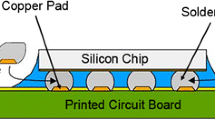Abstract
Recently studies of mechanical properties of lead-free solders show that large reductions in stiffness, yield stress, ultimate strength, and strain to failure (up to 35%) were found after 2 months of aging at room temperature. It also shows that the tensile properties of both lead-free solders and Sn–Pb solders tend to become relatively stable after 10 days of aging at room temperature. In this study, in order to minimize any room temperature aging contribution in the investigation of the dependence of temperature and strain rates, all specimens tested were preconditioned after 10 days of aging at room temperature. All tests were conducted under the same conditions. Testing has been performed at three strain rates, 10−3, 10−4, and 10−5 s−1, in temperature range from −40 to 150 °C. A linear relationship was found between the temperature and the tensile properties (elastic modulus, yield stress, and ultimate stress), while a power law relationship was found between strain rate and tensile properties. Constitutive models have also been developed based on the experimental data with multiple variables of strain rate and temperature for both lead-free and lead content solders. With the obtained constitutive models, tensile properties of lead-free solders can be predicted at any testing strain rate and temperature.














Similar content being viewed by others
References
Hertzberg RW (1996) Deformation and fracture mechanics of engineering materials, 4th edn. Wiley, New York
Jones WK, Liu Y, Zampino MA, Gonzalez G, Shah M (1997) Design and reliability of solders and solder interconnections. TMS, Warrendale
Jones WK, Liu Y, Zampino MA, Gonzalez G (1997) In: Advanced microelectronics, pp 30–34
Shi XQ, Zhou W, Pang HLJ, Wang ZP (1999) J Electron Packag 121(3):179
Pang HLJ, Wang YP, Shi XQ, Wang ZP (1998) IEEE/CPMT electronics packaging technology conference, pp 184–189
Nose H, Sakane M, Tsukada T, Nishimura H (2003) J Electron Packag 124:59
Plumbridge WJ, Gagg CR (1999) J Mater Sci Mater Electron 10:461
Lang R, Tanaka H, Munegata O, Taguchi T, Narita T (2005) Mater Charact 54:223
Dai LH, Lee SR (2001) Proceeding of the ASME InterPACK’05, pp 307–313
Raeder CH, Mitlin D, Messler RW (1998) J Mater Sci 33(18):4503. doi:10.1023/A:1004439931547
El-Rehim AFA (2008) J Mater Sci 43(4):1444. doi:10.1007/s10853-007-2312-4
Ma H, Suhling JC (2009) J Mater Sci 44(5):1141. doi:10.1007/s10853-008-3125-9
Ma H, Suhling JC, Lall P, Bozack MJ (2006) Proceeding of the 56th electronic components and technology conference (ECTC), pp 849–864, San Diego, CA, May 30–June 2, 2006
Gilman JJ (1969) Micromechanics of flow in solids. McGraw-Hill, New York
Author information
Authors and Affiliations
Corresponding author
Rights and permissions
About this article
Cite this article
Ma, H. Effects of temperature and strain rate on the mechanical properties of lead-free solders. J Mater Sci 45, 2351–2358 (2010). https://doi.org/10.1007/s10853-009-4200-6
Received:
Accepted:
Published:
Issue Date:
DOI: https://doi.org/10.1007/s10853-009-4200-6




